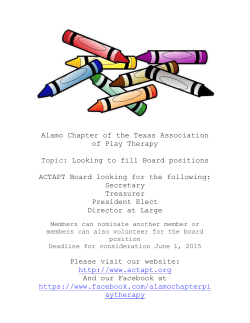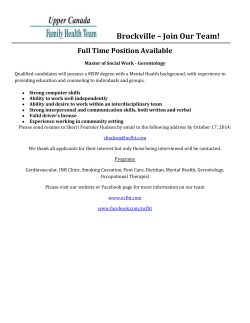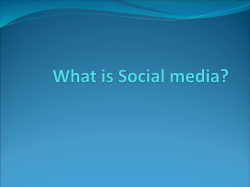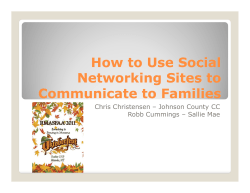
The News Feed Algorithm and the Spread of
The News Feed Algorithm and the Spread of Political Information through Social Networks Yotam Shmargad Assistant Professor School of Information University of Arizona In the wake of the tragic Charlie Hebdo shooting, an international debate about news censorship emerged.1 The Daily Telegraph and The New York Times, along with numerous other outlets, chose not to publish the magazine’s controversial cartoons because of their insensitive nature. The BBC, The Washington Post, and others did publish the cartoons, arguing that the images were a critical part of the story. Regardless of one’s take on whether publishing these cartoons was just or not, this debate points to a fundamental tension in journalism: while the news will sometimes upset us or make us feel uncomfortable, our newspapers nonetheless have an obligation to report it. If we are only exposed to information that we like, we will become increasingly uninformed. As of 2013, nearly a third of Americans get their news from Facebook.2 This number is likely to increase, as Facebook has made recent efforts to host news content directly on its website.3 Most users are unaware of the fact that Facebook may not show them all of the news that their friends post, but rather uses an algorithm to filter the set of potential posts down to a manageable number (Eslami et al. 2015). While Facebook does not make the details of its algorithm publicly available, its developers have stated that the algorithm is tuned to maximize engagement with the site.4 When users like, comment on, or share a post, they receive similar content in the future. It is widely known that people prefer news content that conforms to their preexisting beliefs (Sears and Freedman 1967). This raises a concern that Facebook’s algorithm may conceal news stories that do not conform to one’s beliefs. I propose we discuss the extent to which we should treat social media companies like newspapers, and encourage them to show users news that may contradict their preexisting beliefs or preferences. There are at least two ways to analyze whether or not Facebook’s algorithm tends to hide news that does not conform to a user’s political preferences. The first is to capture the content contained in the posts that each user sees and does not see, categorize these posts as left-leaning/liberal/democrat or right-leaning/conservative/republican, and compare the relative ratios of posts seen within these two 1 http://www.thedailybeast.com/articles/2015/01/14/who-did-and-didn-t-publish-the-charlie-hebdo-coverimage.html (accessed 3/29/2015) 2 http://mashable.com/2013/10/24/1-in-3-americans-get-news-on-facebook/ (accessed 3/29/2015) 3 http://www.latimes.com/opinion/op-ed/la-oe-ford-facebook-20150329-story.html (accessed 3/29/2015) 4 https://www.facebook.com/business/news/News-Feed-FYI-A-Window-Into-News-Feed (accessed 3/29/2015) categories to the user’s disclosed political preferences. The second, more indirect way of addressing this question is to leverage insights from the social networks literature. Granovetter’s (1973) classic result in this area suggests that new information comes from those with whom we do not have frequent contact. Bakshy et al. (2012) show that, on Facebook, users are more likely to share information that they receive from socially weak ties than strong ones. However, their study took place before Facebook’s algorithm entered the public consciousness. Since then, Facebook has started prioritizing content from strong ties. I propose that we discuss the extent to which the Facebook algorithm decreases the amount of information that users receive from their weak ties, and the consequences that the algorithm might have for bipartisan discourse. According to Granovetter (1973), weak ties provide access to new information because they are bridges to regions of the network to which people would not otherwise be connected. Networks with many bridges are said to be low-clustered, while those in which one’s ties are connected to each other and not to different regions are said to be high-clustered (see figure below). Klar and Shmargad (2015) show that high-clustered networks produce local biases, because people in them have less access to viewpoints that exist in different regions of the network. Moreover, the authors show that high-clustered networks also serve to exacerbate over-exposure to dominant perspectives and a relative under-exposure to minority perspectives. Since Facebook’s algorithm prioritizes information from strong ties, Granovetter’s theory would predict that information from bridge ties is suppressed. I propose that we discuss the extent to which the Facebook algorithm suppresses information from bridge ties, and the consequences this might have for groups with few resources to seed messages in different regions of the network and who thus depend on bridge ties to disseminate their messages. References Eslami, M., A. Rickman, K. Vaccaro, A. Aleyasen, A. Vuong, K. Karahalios, K. Hamilton, and C. Sandvig (2015), “I always assumed that I wasn’t really close to [her]: Reasoning about invisible algorithms in the news feed”, CHI 2015 Sears, D. O. and J. L. Freedman (1967), “Selective Exposure to Information: A Critical Review,” The Public Opinion Quarterly, 31(2), 194-213 Granovetter, M. S. (1973), "The Strength of Weak Ties," American Journal of Sociology, 78(6), 1360-1380 Bakshy, E., I. Rosenn, C. Marlow, and L. Adamic (2012), “The Role of Social Networks in Information Diffusion”, Proceedings of the 21st International Conference on World Wide Web Klar, S. and Y. Shmargad (2015), “The Effect of Network Structure on Preference Formation,” working paper
© Copyright 2025










